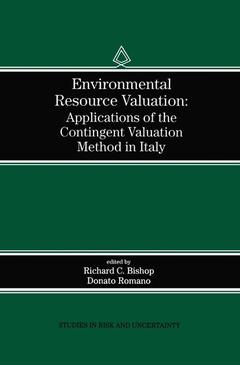Environmental Resource Valuation, 1998 Applications of the Contingent Valuation Method in Italy Studies in Risk and Uncertainty Series, Vol. 11
Coordonnateurs : Bishop Richard C., Romano Donato

Why depart from well-established revealed-preference procedures and apply a `stated-preference' method like CVM? For nonmarket goods and services, revealed-preference methods have two shortcomings that those applying CVM hope to avoid. First, revealed-preference methods involve econometric problems that have yet to be fully overcome. The second shortcoming of revealed-preference methods is that such methods, when applied to environmental amenities, are likely to be only partial measures of value.
Given the tremendous interest that exists in economic values and the limitations of revealed-preference methods, it is not surprising that interest in CVM has grown rapidly. Environmental Resource Valuation reviews the application of CVM and compares American experiences in nonmarket evaluation with those in other countries.
Date de parution : 10-2012
Ouvrage de 286 p.
15.5x23.5 cm
Disponible chez l'éditeur (délai d'approvisionnement : 15 jours).
Prix indicatif 105,49 €
Ajouter au panierThèmes d’Environmental Resource Valuation :
Mots-clés :
Conservation; Italy; consumer; econometrics; environment; evaluation; information; modeling; research; science and technology; service; valuation



